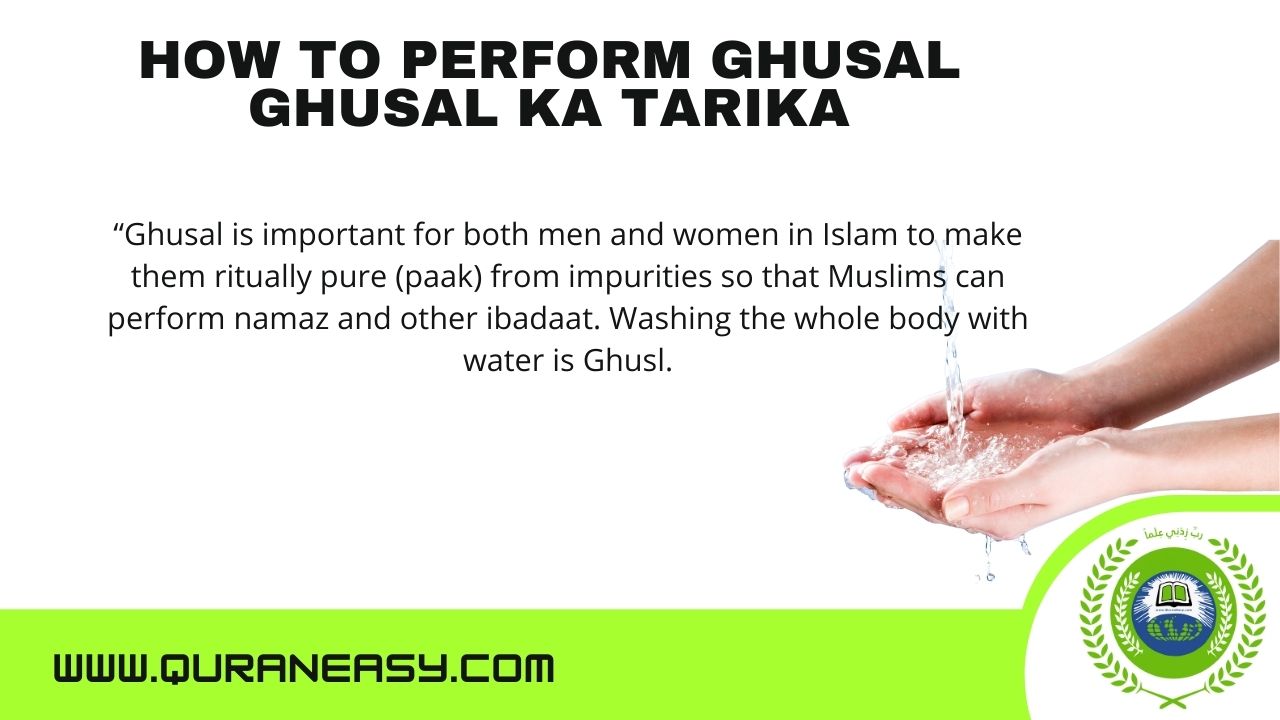Ghusal is important for both men and women in Islam to make them ritually pure (paak) from impurities so that Muslims can perform namaz and other ibadaat. Washing the whole body with water is Ghusl. We have listed below Ghusl ka tarika for female in English along with Ghusl ka tarika for male in English.
In Quran Allah (SWT) says
“O you who believe! Approach not As-Salat (the prayer) when you are in a drunken state until you know (the meaning) of what you utter, nor when you are in a state of Janaba, (i.e. in a state of sexual impurity and have not yet taken a bath) except when traveling on the road (without enough water, or just passing through a mosque), till you wash your whole body. And if you are ill, or on a journey or one of you comes after answering the call of nature, or you have been in contact with women (by sexual relations), and you find no water, perform Tayammum with clean earth and rub therewith your faces and hands (Tayammum) . Truly, Allah is Ever Oft-Pardoning, Oft-Forgiving.” (Quran 4:43)
How to perform Ghusl Step by Step (for men and women) – 11 Steps to Perform Ghusal
- First of all, the performer should intend to perform ghusl in his heart (not verbal) and say BISMILLAH.
- Then wash the private part to wash off the impurities.
- Wash the right hand all the way up to the wrists. Make careful to rub and rub between the fingers of your hand while doing so. As a result, make sure that no area of the hand is left dry (for three times). Then repeat with the left hand also three times.
- Make a cup with your right hand, then take water into your mouth with this hand, swirl it around within your mouth, and then expel it out of your mouth. Then take the remaining water from your cupped right hand and sniff it into your nose, then blow it out and remove the water from your nose with your left hand. Repeat three times. Some people wash their mouth three times before rinsing their nose three times. The first way, however, is the most accurate.
- From the hairline to the jawbone and chin, and from the beginning of the ear to the beginning of the ear, wash the face three times. After that, a male should wash his beard hair by entering a handful of water underneath his chin, rubbing it through his beard, and running wet fingers through the beard one time.
- Wash the right arm all the way up to the elbow. Three times in total. The arm extends from the fingertips to the lower part of the upper arm, including the nails. Before washing your hands, remove anything clinging to them, such as dough, mud, paint, or nail polish that could block the water from reaching the skin. Carry out the same procedure with the LEFT ARM 3 times.
- Saturate the head with water Three times down to the hair’s roots. running damp fingers through the hair’s roots
- Pour water liberally over the entire body, starting on the right side and working your way to the left. Then pour water over your head, kneading your body with your hands to ensure that no area of your body is left dry.
- Remove yourself from the place where you performed ghusl and Wash the right feet three times, up to and including the ankles.
- You should dip your little finger into the water between your toes and then wash your feet (not wipe them, but wash them), being sure to clean the sole of your foot and the heals thoroughly. Make certain that no area of the foot is exposed to the elements. Wash the left foot three times in the same way as the right foot.
- Then say what follows: When you’re outside the bathroom, say a dua for Wudhu if the bathroom has a toilet inside it
Join Our one on one Quran Classes for kids Online with experienced Quran Tutors, In Ramadan we offer 30% Off and 3 Days free trial Classes
Click here to Join Online Quran classes now
Ashhadu an laa ilaaha ill-Allaah wahdahu laa shareeka lah, wa ashhadu anna Muhammadan abduhu wa rasooluhu.
(I bear witness that there is no god except Allah alone, with no partner or associate, and I bear witness that Muhammad is His slave and Messenger.)
Allaahumm aj alni min al-tawwaabeena waj alni min al-mutatahhireena
( O Allah, make me one of those who repent and make me one of those who purify themselves)
How Hazrat Muhammad (PBUH) performed ghusl
“When Allah’s Messenger (sallAllaahu ‘alayhi wa sallam) would perform ghusl due to Janaabah, he would begin by washing his hands,” according to the hadeeth of Aishah (radyAllaahu anhaa) in Al-Bukhaaree and Muslim “Then he’d pour water from his right to his left hand and use it to bathe his private regions (i.e. the left hand). Then he’d do some wudoo (ablution). Then he’d get some water and put his (wet) fingers on his hair roots. Then he’d take three handfuls of water and dump them over his head. Then he’d saturate the remainder of his body with water. He’d then wash his feet.” Muslim coined this phrase.
Particular note for ghusl for females
The Ghusl is the same for men and women. If they are in Jannabah, women with braids can do ghusl without having to undo their hair. They should expose their hair before practicing ghusl if they are impure due to menstruation or Nifass .
Hazrat ume Salamah remarked that she asked Holy prophet (PBUH)
“O Messenger of Allaah, I am a woman who wears her hair in braids. Do I have to undo my braids when I make ghusl because of janaabah?
Hazrat Muhammad (PBUH) replied
“No, it is enough if you pour water on your head three times, and then over the rest of your body. That will make you clean.”
Also, if the Muslim female is making ghusl after the end of her menstruation or Nifass, she should take a piece of musk-scented cloth and wipe her private parts three times after the ghusl.
Hazrat Aisha said, “An Ansari woman asked the Prophet how to take a bath after finishing from the menstruation. Holy Prophet (PBUH) replied, “Take a piece of cloth perfumed with musk and clean the private parts with it thrice.” (Bukhari Volume 1, Book 6, Number 312:)
Apart from that, there is no difference between men and women when performing Ghusl.






Leave A Comment